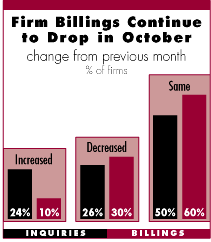
Firms expecting easing in 2002 billings

by Kermit Baker, PhD
AIA Chief Economist
Indicating that the construction industry will not immediately bounce back after the September terrorist attacks, billings at architecture firms dipped further in October. Some 30% of firms reported a decline in billings compared to September levels, while only 10% reported gains.
 Firms
of all types affected
Firms
of all types affected
Firms in all regions reported declines, although for firms in the South
the overall decline was modest because almost as many firms reported gains
as reported declines. Larger firms did not fair any better that smaller
firms in October; the drop-off was about the same for firms in all size
categories. Even firms focusing in the more stable institutional building
sectors reported a fall in billings. In fact, firms concentrating in the
weaker commercial/industrial sectors reported business conditions just
about on par with those serving the residential and institutional markets.
After a drop in September, inquiries for new projects stabilized in October. About the same number of firms reported a drop in inquiries (26%) as reported an increase (24%). While new inquiries are about the same across firms of all sizes, a higher share of firms in the South and Midwest reported an increase in new inquiries in October.
Even though billings declined at firms concentrating in the institutional sector, improvement appears in the works for firms serving these markets. Fully a third of firms concentrating their practice in these building types (education, health, public, cultural, religious, etc.) reported an increase in inquiries in October, compared to only 20% reporting declines. Even in the volatile commercial/industrial sector, almost as many firms reported increases in inquiries for new projects as reported declines.
Economic softness
persists
The pronounced weakness in the economy that began after September 11 apparently
has not reached bottom yet. Consumer confidence figures, which have dropped
significantly over the past two months, have not begun to recover. The
manufacturing sector declined for the 13th consecutive month in October,
with no indications that that sector will reverse direction anytime soon.
The Fed has been aggressive in reducing short-term rates; the prime rate
now stands at 5%, a rate not seen in almost 30 years. However, lower rates
have not been enough as yet to encourage businesses to undertake new capital
spending initiatives.
 Firms
expecting a weak 2002
Firms
expecting a weak 2002
Overall, firms are expecting billings to decline a modest amount next
year, somewhere between 2% and 3%. Over 40% of firms are expecting a decline
of at least 5% from 2001 levels, while less than a quarter are expecting
an increase of that magnitude. Firms in the West are expecting the steepest
drop-over half are expecting declines, compared to only 12% expecting
increases—while firms in the Midwest are anticipating business conditions
about on par with this year.
In general, smaller firms are expecting more favorable business conditions next year. While firms focusing on residential, commercial/industrial, or institutional buildings all expect a modest drop-off in billings next year, firms with a mixed practice—those with less than 50% of their work in any of the major sectors—anticipate a more substantial decline.
Copyright 2001 The American Institute of Architects. All rights reserved.
![]()
|
Stand Up and Be Counted—Join the Work-on-the-Boards Survey Team Be one of the hundreds of firm principals who spend just a few minutes each month answering a fax-back survey (usually two questions). For more information on how to participate, send an email to Jennifer Schauer, call her, 202-626-7532, or send her a fax, 202-626-7527. |
|